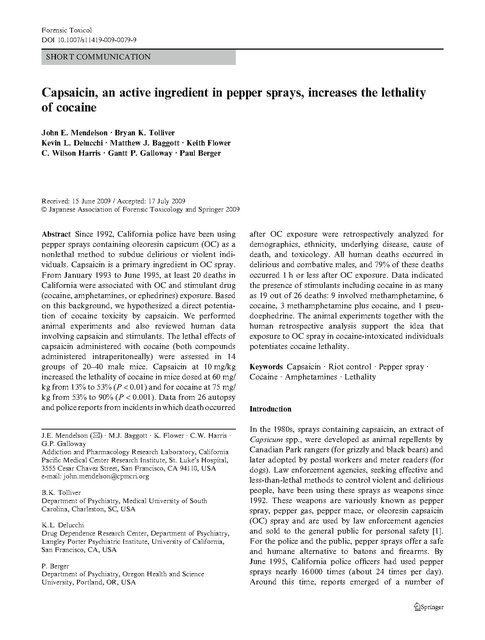Forensic Toxicology Chemical in Pepper Spray Increases Lethality of Cocaine 2009
Download original document:

Document text

Document text
This text is machine-read, and may contain errors. Check the original document to verify accuracy.
Forensic Toxicol DOI 10.1007/s11419-009-0079-9 SHORT COMMUNICATION Capsaicin, an active ingredient in pepper sprays, increases the lethality of cocaine John E. Mendelson · Bryan K. Tolliver Kevin L. Delucchi · Matthew J. Baggott · Keith Flower C. Wilson Harris · Gantt P. Galloway · Paul Berger Received: 15 June 2009 / Accepted: 17 July 2009 © Japanese Association of Forensic Toxicology and Springer 2009 Abstract Since 1992, California police have been using pepper sprays containing oleoresin capsicum (OC) as a nonlethal method to subdue delirious or violent individuals. Capsaicin is a primary ingredient in OC spray. From January 1993 to June 1995, at least 20 deaths in California were associated with OC and stimulant drug (cocaine, amphetamines, or ephedrines) exposure. Based on this background, we hypothesized a direct potentiation of cocaine toxicity by capsaicin. We performed animal experiments and also reviewed human data involving capsaicin and stimulants. The lethal effects of capsaicin administered with cocaine (both compounds administered intraperitoneally) were assessed in 14 groups of 20–40 male mice. Capsaicin at 10 mg/kg increased the lethality of cocaine in mice dosed at 60 mg/ kg from 13% to 53% (P < 0.01) and for cocaine at 75 mg/ kg from 53% to 90% (P < 0.001). Data from 26 autopsy and police reports from incidents in which death occurred J.E. Mendelson (*) · M.J. Baggott · K. Flower · C.W. Harris · G.P. Galloway Addiction and Pharmacology Research Laboratory, California Pacific Medical Center Research Institute, St. Luke’s Hospital, 3555 Cesar Chavez Street, San Francisco, CA 94110, USA e-mail: john.mendelson@cpmcri.org B.K. Tolliver Department of Psychiatry, Medical University of South Carolina, Charleston, SC, USA K.L. Delucchi Drug Dependence Research Center, Department of Psychiatry, Langley Porter Psychiatric Institute, University of California, San Francisco, CA, USA P. Berger Department of Psychiatry, Oregon Health and Science University, Portland, OR, USA after OC exposure were retrospectively analyzed for demographics, ethnicity, underlying disease, cause of death, and toxicology. All human deaths occurred in delirious and combative males, and 79% of these deaths occurred 1 h or less after OC exposure. Data indicated the presence of stimulants including cocaine in as many as 19 out of 26 deaths: 9 involved methamphetamine, 6 cocaine, 3 methamphetamine plus cocaine, and 1 pseudoephedrine. The animal experiments together with the human retrospective analysis support the idea that exposure to OC spray in cocaine-intoxicated individuals potentiates cocaine lethality. Keywords Capsaicin · Riot control · Pepper spray · Cocaine · Amphetamines · Lethality Introduction In the 1980s, sprays containing capsaicin, an extract of Capsicum spp., were developed as animal repellents by Canadian Park rangers (for grizzly and black bears) and later adopted by postal workers and meter readers (for dogs). Law enforcement agencies, seeking effective and less-than-lethal methods to control violent and delirious people, have been using these sprays as weapons since 1992. These weapons are variously known as pepper spray, pepper gas, pepper mace, or oleoresin capsaicin (OC) spray and are used by law enforcement agencies and sold to the general public for personal safety [1]. For the police and the public, pepper sprays offer a safe and humane alternative to batons and firearms. By June 1995, California police officers had used pepper sprays nearly 16 000 times (about 24 times per day). Around this time, reports emerged of a number of 13





